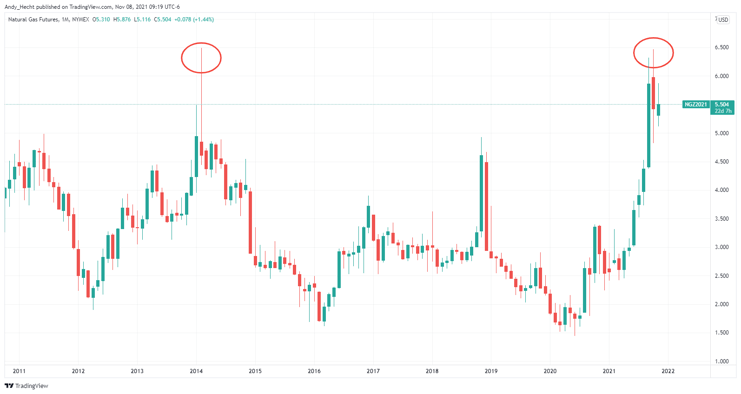November 8, 2021
Quality and Location Spreads Provide Fundamental Clues
By Andrew Hecht
- Market structure- We looked at processing spreads and term structure
- Location-location-location is the real estate mantra- It applies to commodities too
• Different qualities command premiums or discounts - The Brent-WTI spread- A combination of a location and quality spread and more
- Another part of market structure that can provide valuable clues and makes the pieces of the puzzle form a picture
My introduction to commodity markets came in the 1970s when I was invited to work for the summer for the world’s leading commodity merchant company. In the 1970s, Philipp Brothers’ headquarters were in the heart of New York City. The company had offices all over the world. Where it did not have an office, it had a network of agents. Philipp Brothers bought commodities from producers and provided financing for raw materials production and sold to consumers. In an era of rising inflation in the late 1970s, the company was so profitable that it bought the leading Wall Street, privately held bond trading and investment banking firm, Salomon Brothers.
My first job was delivering telex messages to trading and traffic departments. Traders were the kings, earning millions in profits. The traffic department arranged the logistics of moving raw materials around the globe from production points to consuming locations. The telex messages contained information about proposed transactions and completed ones. I read each one with great interest. Those messages turned out to be an invaluable education in the business.
The high school job turned into a lifelong career. The excitement of markets and the global nature of the commodities business was a powerful force that caused me to forgo law school for a career as a commodity trader.
I view the commodity markets as a jigsaw puzzle with many moving pieces. Each market has idiosyncratic characteristics. Quality and location are parts of each market’s structure and can provide insight into the path of least resistance of prices.
Market structure- We looked at processing spreads and term structure
Over the past two weeks, I highlighted processing spreads and term structure, two critical puzzle pieces. In the future, I will cover substitution spreads and the essential technical factors that held uncover a picture of the path of least resistance for prices.
Processing spreads tell us about the demand for one commodity that is a product of another. Crude oil crack spreads and soybean crush spreads were examples.
Term structure tells us about the supply-demand balance as backwardation where deferred prices are lower than nearby prices for the same commodity indicates supply shortages or concerns. Contango, where deferred prices are higher, suggests plenty of nearby supplies to satisfy demand or a market is in equilibrium with supply and demand balanced.
This week, we will look at location and quality spreads covering the same commodity’s regional dynamics and different compositions. These spreads shed light on areas of the world where a commodity may trade at a significant differential or where other forms or variations of the same commodity are at premiums or discounts, which could signal price changes.
Location-location-location is the real estate mantra- It applies to commodities too
A location spread reflects the price of the same commodity for delivery in one location or area versus another. The most recent example of substantial location differentials has been in the natural gas market.
The natural gas futures contract on the CME’s NYMEX division reflects the price of the energy commodity for delivery at the Henry Hub in Erath, Louisiana.
The chart shows that in October 2021, the futures reached the highest price since February 2014 when they traded to a high of $6.466 per MMBtu, only 2.7 cents below the 2014 $6.493 high.
Meanwhile, shortages of natural gas in Asia and Europe pushed the energy commodity price over five times higher than the NYMEX futures price. Since natural gas in liquid form travels the world via ocean vessels, the high prices in Asia and Europe have a bullish impact on US prices.
Meanwhile, prices in the US can vary dramatically from the NYMEX Henry Hub price, which is a benchmark. Following the price action in natural gas swaps between one US region and others can provide clues about the energy commodity’s price path.
Commodity production tends to be localized in areas of the world where the earth’s crust contains reserves or the soil and climate support crop growth. Consumption is widespread as people worldwide require essential staples. When local shortages occur, prices can rise to substantial premiums to benchmarks. In glut conditions, they can fall to significant discounts. Monitoring these location differentials in all commodities provides valuable information about supply and demand characteristics.
Different qualities command premiums or discounts
A quality spread is the price differential between one form or composition of a commodity and another in the same raw material. An example is the price differential for one hundred-ounce bars of gold and four hundred-ounce bars of gold. Each COMEX contract calls for 100 ounces of the precious metal, the US standard of trade. The London gold market is a far more active wholesale market, where the standard of trade calls for the four hundred-ounce bars. Price differentials reflect the price and time to process one form of gold into the other. Significant premiums or discounts of either size bars, or different sizes such as kilos bars, one-ounce bars, or others, can tell us about retail or wholesale gold demand.
When we drink a cup of coffee, we rarely think of the origin of the beans that are ground into the caffeinated beverage. Arabica coffee beans trade in the futures market on the Intercontinental Exchange. The Arabica beans tend to be most popular in the US. Starbucks, Dunkin Donuts, and most US establishments offer Arabica coffee to consumers. Brazil is the world’s leading producer of Arabica beans.
Meanwhile, Vietnam is the leading product of Robusta coffee, which is the beans required for espresso coffees. Robusta coffee futures trade on the Intercontinental Exchange in Europe. A weather event in Vietnam or Brazil can cause supply issues for Arabica or Robusta beans, leading to a price change in one or both variations of the soft commodity.
There are many other examples of quality spreads where one form or size of a commodity can experience supply or demand changes that impact the overall price action in the raw materials.
The Brent-WTI spread- A combination of a location and quality spread and more
The Brent-WTI crude oil spread is an example of a location and a quality spread. Brent is the benchmark pricing mechanism for approximately two-thirds of the world’s petroleum producers and consumers. While Brent refers to crude oil from the North Sea, the futures contract reflects output from Europe, Africa, the Middle East, and other parts of the world. Brent futures trade on the Intercontinental Exchange. The Middle East is the home of over half the world’s petroleum reserves, making the Brent benchmark the most ubiquitous.
West Texas Intermediate crude oil or WTI is a benchmark for approximately one-third of the world’s producers and consumers. WTI futures trade on the CME’s NYMEX division. Crude oil in many other locations trades at premiums or discounts to the Brent and WTI prices.
Both Brent and WTI are sweet crude oils, meaning they have low sulfur content. However, WTI tends to be slightly sweeter, making it the preferable petroleum for refining into gasoline. Brent petroleum is heavier, making it more suitable for refining into distillate fuels like heating oil, jet and diesel fuels, and other products. The specific gravity and sulfur content are the essence of the quality spread between the two benchmark crude oils. The Brent-WTI spread tends to be a helpful tool for monitoring the price differentials between the two lead petroleum benchmark prices.
 Source: CQG
Source: CQG
The daily chart of the price of January NYMEX WTI minus nearby January Brent futures shows the spread was trading at a $2.52 premium for Brent over WTI as of November 5. The spread rose from a $1.88 premium on November 1. In 2021, the nearby Brent-WTI spread has ranged from a 96 cents premium for Brent to a $4.48 per barrel premium for the Brent futures.
While Brent versus WTI can tell us about the supply and demand for the two benchmark crude oils, it also reflects the level of political risk in the Middle East, making the spread a multi-purpose indicator.
Meanwhile, Brent and WTI may be the two benchmark petroleum prices with actively traded futures markets, but many other crude oils in locations worldwide with different chemical compositions trade in the physical market. The other petroleums tend to trade at discounts or premiums based on supply and demand. Monitoring the Brent-WTI spread and the premium or discount structures in the global oil market are pieces of the overall supply and demand puzzle that can enhance price forecasting.
Another part of market structure that can provide valuable clues and makes the pieces of the puzzle form a picture
Location and quality factors can reveal underlying fundamental trends in a commodity. Comparing current levels to historical ones and explaining the changes often leads to an improved understanding of previous price trends and can help predict the future path of least resistance of prices.
Location and quality differentials are parts of a market’s overall structure. Combined with the other structural factors, they can uncover opportunities that improve the odds of success.
Trading advice given in this communication, if any, is based on information taken from trades and statistical services and other sources that we believe are reliable. The author does not guarantee that such information is accurate or complete and it should not be relied upon as such. Trading advice reflects the author’s good faith judgment at a specific time and is subject to change without notice. There is no guarantee that the advice the author provides will result in profitable trades. There is risk of loss in all futures and options trading. Any investment involves substantial risks, including, but not limited to, pricing volatility, inadequate liquidity, and the potential complete loss of principal. This article does not in any way constitute an offer or solicitation of an offer to buy or sell any investment, security, or commodity discussed herein, or any security in any jurisdiction in which such an offer would be unlawful under the securities laws of such jurisdiction.

